 THE
DESERT CAVES
THE
DESERT CAVESBOOK REVIEW - © 2005 by John and Susy Pint
OF SAUDI ARABIA
By John Pint
Saudi Geological Survey
Twenty years of underground exploration, photography and adventure deep below the stark deserts of Saudi Arabia are brought to light in this elegant, hardback volume published by Stacey International of London for the Saudi Geological Survey. The book has 120 pages of carefully chosen photographs with text both in English and Arabic. For information on ordering it, go to the bottom of this page. As you scroll down, you can take a peek at some of the pictures included in Desert Caves – plus a few that were left out — and you will be exposed to the author's ruminations over the joys and woes that eventually gave birth to a new book. If you prefer to skip the pictures and stories, you can go straight to orders
“Would you like to write a book about the caves you explored before joining us?” asked Dr. Maher Idris shortly after I was hired by the Saudi Geological Survey. Before I could answer, he added, “…and I’d like to see it in print by the end of the year.”
Well, I‘ve written a few books and none of them ever reached publication in less than two years. So, I figured I’d better get cracking and that very day I began work on Desert Caves of Saudi Arabia. A month later, all the photographs had been chosen and scanned and the English text was done… but it still took two-and-a-half years for the manuscript to become a book.
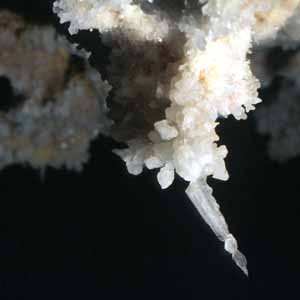 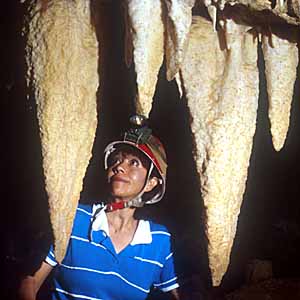 Photos
from Desert Caves of Saudi Arabia Photos
from Desert Caves of Saudi Arabia
Susy Pint explores perfectly named Surprise Cave where the tiniest formations are as dramatic as the biggest ones. |
Anyone who has read one of the reports that Susy and I and others, have written on what happened during our years of exploring Saudi Caves will realize that these anecdotes would add up to a great deal of material, some of it more related to culture than speleology, some of it humorous, some of it a bit irreverent and most of it far removed from the technical style of report-writing favored by geologists. The aim of SGS in producing a cave book, however, was basically to demonstrate – in a dramatic and visual way – that Saudi Arabia has caves (a fact unknown to most of the world) and that many of these caves contain beautiful, delicate formations which are going to be destroyed or removed unless somebody does something to protect them (a fact that has not yet impacted the decision-makers of the country)
|
Photos from Desert Caves of Saudi Arabia
|
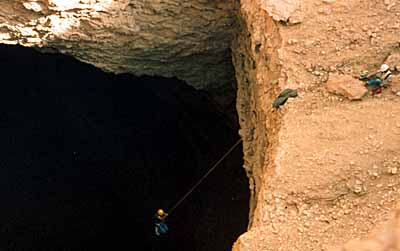 |
This seemed a practical and worthwhile goal, so, rather than weaving a web of anecdotes about early cave exploration in Arabia, the book relies on a relatively small number of pictures to create an overview which is accompanied by a small amount of text that can be read at one sitting. If you want the real story, dear friends, hold on a little: we’re working on it!
Desert Caves features the most visually attractive caves we explored during the last two decades of the 20th century. These are arranged in chronological order as much as possible, beginning with our discovery of Dahl Sultan in 1983 up to the first cave explorations by the Saudi Geological Survey in 2000. Even though the story starts in 1983, I couldn’t resist paying tribute to those amazing geologists who — sixty years ago — lived the rough life of the Bedouin and occasionally took refuge in the caves to escape the burning sun of summer or the bone-chilling winds of winter. Their deeds are recorded in the fascinating book Out in the Blue and the collection of early Arabian photographs artfully displayed at www.outintheblue.com thanks to Tim Barger, amazing son of one of those amazing geologists.
DAHL SULTAN
|
Photos from Desert Caves of Saudi Arabia
creeps between stalactites and sand in Dahl Sultan. This is just one of many outstanding photos by Lars Bjurström.
|
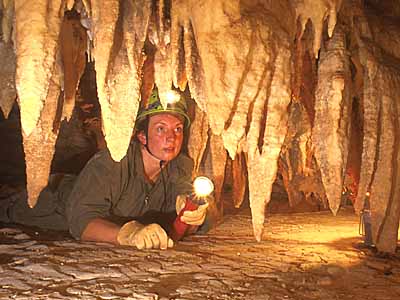 |
The story of our long and patient search for Ma’aqala and the fortuitous discovery of Dahl Sultan first appeared in The Caves of Ma’aqala (NSS News, September, 1985). You’ll notice that “over 600 meters” of the cave had been surveyed at that point with several nice passages still awaiting exploration and mapping. Since Dahl Sultan shows great potential for being the longest limestone cave in Saudi Arabia, why hasn’t the survey been continued?
The shameful truth is that we mappers lost interest when we discovered that four or five dead sheep had been chucked down the artificially widened entrance hole, producing a stench five times worse than what we had previously been treated to during the early years when there was only one rotting body to crawl over. A number of years later, Lars Bjurstrom and Arleen Foss heroically offered to remove the cadavers. All day long they toiled, filling garbage bag after garbage bag with decaying flesh and bones. Having removed all of it, they went back to their camp to celebrate their Herculean labor. The next morning, they returned to Dahl Sultan only to find that every single putrid carcass had been chucked back inside the hole. That’s one scene that didn’t make it into the book!
MURUBBEH / B7, ETC.
This cave has more names than a Spanish nobleman. Besides Murubbeh and B7, it has been called Shawiyah Cave, Quad, Crystal Palace and Bat Cave. You can almost figure out its recent history by the names. Dave Canning, Susy and I found it in 1995 while trying to track down the Bat Cave mentioned by Dave Peters in the June 1990 NSS Bulletin.
We should have known we had succeeded when we found a very long piece of computer tape strung through the cave. But in those days, we thought similar tape had been left by “the Austrians,” a team of speleologists we had heard rumors about for many years. Only much later did we learn that the tape was not Austrian, but American!
|
Photos from Desert Caves of Saudi Arabia
|
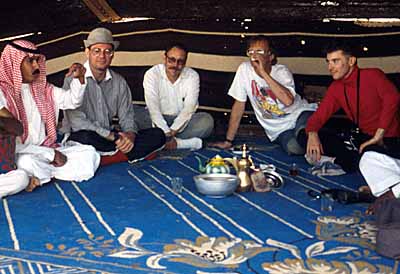 |
Murubbeh is the name we got for this cave from local boys. It means “square” – thus the name Quad – and is apparently used in Yemen to describe man-made, square structures built in remote places as refuges from the burning sun. Because this cave is principally used for the very same purpose, it might have been called a “murubbeh” by someone with southern roots, who knows? At the far end of this cave we found chambers everywhere lined with marvelous, shimmering calcite crystals. And so, it became the Crystal Palace. “This couldn’t be Dave Peters’ Bat Cave,” we figured, “because there are no bats.”
Well, on our next visit, we found not only bats, but a whole new section of the cave we had missed the first time around. A few minutes inside this new area told us we were looking at a lot more than a bat roost. Everywhere we found bones of all sizes from a great variety of animals and a few human beings as well, all covered with the dust of ages. Only after surveying the cave did we discover that the Austrians had been here, had named the cave B7 (employing a somewhat more Spartan system of nomenclature than we do) and had mapped it (but had NOT left that infamous computer tape!) You can learn a bit more about the important work done by the KFUPM-Austrian Academy team in Chapter Three of the book.
After explaining some of the wonders of Murubbeh Cave to a local man, he informed us that “no one calls this cave Dahl Murubbeh! Its correct name is Dahl Shawiyah.” Normally, we always give caves the names used locally. However, in this case we had second thoughts when we had a look at the business card we had received from our informant, who was in the military. His family name, it turned out, was Shawiyah!
Now it’s time to insert a few pictures that did not make it into the book…
|
TAKE OUTS
|
|
TAKE OUTS
|
|
TAKE OUTS
|
THE OBSTACLE COURSE
Up above, before inserting all those take-outs, I mentioned that the pictures and English text were all finished by the end of January 2001. So what happened between then and June 2003 when Desert Caves finally reached the bookstores?
Well, I guess government agencies everywhere in the world have a lot in common. You can’t just pick your publisher and let the presses roll. No, there’s this little procedure requiring you to find three bidders to do the job. How this procedure could have taken a full year’s time, I cannot figure out, especially because no one we found had anywhere near the quality we required except Stacey International (which deserves a prize for being the world’s most patient publisher!) Next came contracts and other paperwork, gobbling up many months, but that wasn’t nearly as complicated as the long, tortuous path to producing the Arabic translation of the text.
Now, you’ll notice that there isn’t a whole lot of text in this book to start with... just a short paragraph about each cave and captions for the pictures. However, you would have thought that the fate of nations hung upon every word in this book as various individuals wrote, scrutinized, rescrutinized and rewrote nearly every sentence. At the end, I was convinced that the Arabic text of Desert Caves – unlike the English – must be a veritable paragon of perfect prose, worthy of being quoted around a flickering camel-dung fire on one of those moonless nights under a canopy of stars stretching across the vast Arabian desert from horizon to far horizon.
Most likely, the Arabic version of this book is the closest I will ever come to producing literature!
John Pint
|
LAST TAKE OUT Finally, to all you wonderful people in Ma'aqala and Shawiyah, a great big SHUKRAN and I just hope we will find some way to give each of you a copy of the book! |
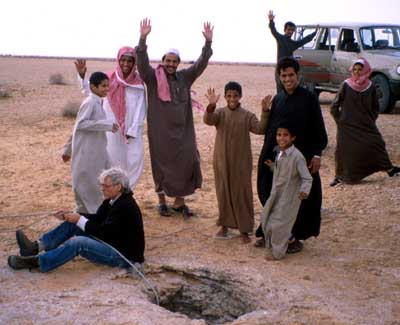 |
For information on ordering THE DESERT CAVES OF SAUDI ARABIA in the USA, see www.speleobooks.com. For ordering it anywhere else, go to www.stacey-international.co.uk. In Saudi Arabia, just check out any large bookstore or —if you live in Jeddah — call 619-7704 Xtn 3406 for a discount!